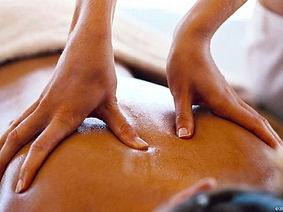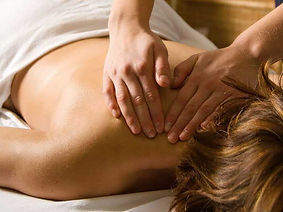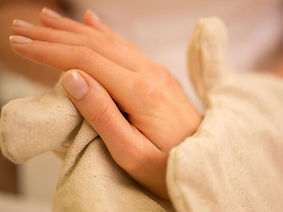

Ayurveda
Ayurveda is a thousands-year-old healing art and collected wisdom for natural health and inner development, which has its origins in India and the Vedic tradition. The words ayur and veda are Sanskrit. Ayur means life and veda means knowledge. Chinese medicine as well as early Greek medicine have their roots in Ayurveda. Today, Ayurveda is practiced all over the world both as traditional medicine and as alternative medicine.
Ayurveda describes how we are affected by our lifestyle, our environment, our relationships, our body, our mind, our thoughts and our consciousness. Understanding people's differences and unique resources is an essential asset in Ayurveda. We are all unique in body constitution and mind from birth, and therefore we have different needs for nutrition, sleep and exercise. Needs that change to some extent with age and seasonal changes.
Ayurveda is a complex health system, but its basic principles are simple and practical to use. Everything around us, from the macrocosm down to the cellular level, is made up of the five elements; space, air, fire, water and earth. These five elements form three doshas/dynamic forces, which in Sanskrit are called vata, pitta and kapha. Each dosha in turn has five subdoshas.
Vata is made up of the elements of space and air. Vata stands for communication, circulation, movement, enthusiasm, inspiration, is responsible for the nervous system, elimination, breathing, transportation, imagination and vitality.
Pitta is primarily the fire element in the body, responsible for our digestion, our metabolism, our intellect, our inner and outer vision, our appetite and thirst, our luster. Pitta is the driving and transforming force in the body.
Kapha, which is made up of the earth and water elements, lubricates our joints, our lungs and our brain. Kapha stands for cohesion, immunity. Kapha creates our body shape and weight. Kapha stands for stability and heaviness. Kapha has a wound-healing ability and stands for unconditional love, affection, understanding and our ability to forgive.
The combination of vata, pitta and kapha is unique to each person. All three doshas are always present, but usually one or two are dominant. The relationship between the doshas is not constant throughout life, but is constantly changing through the influence of external and internal factors such as food, exercise, thoughts and emotions. A dosha can become unbalanced, which over time can lead to illness. The wisdom of Ayurveda gives you the key to understanding yourself better, so that you can maintain your natural health.
Balance is the key to health
Balance is health according to Ayurveda, but the way to achieve balance is not the same for all people. By adapting the base oil, adding essential oils and herbs to the base oil and controlling the pace of the treatment, I individualize each treatment based on your needs right here and now. If you wish, I will start from what I feel in your pulse, as I am trained in Ayurvedic pulse diagnostics.
Treatments
Ayurvedic massages and treatments help you add years to your life and life to your years. In Ayurveda, external treatment is considered to be as effective as internal treatment.
Ayurvedic treatments are best performed in silence as the aim is to create peace and quiet and calm mental activity. In rest, healing begins and the body's self-repairing mechanisms are activated.
About Evelina
If you would like to book a treatment or an Ayurvedic health consultation, send an email to Evelina
Abhyanga

Abhyanga is a very pleasant full-body massage with warm oil. The body is massaged systematically with relatively light pressure and calm, sweeping movements. The treatment strengthens the nervous system and is deeply relaxing for body and mind. Circulation and vitality increase in muscles and joints are softened. The heat, oil and movements cleanse the body of waste products. Abhyanga is especially beneficial for vata imbalances and during autumn and winter.
Vishesh

Vishesh is a slightly more powerful full-body massage where the pressure is increased compared to abhyanga. Vishesh has the effects of abhyanga but can also release deep-seated tensions. The increased pressure in the sweeping movements stimulates the muscles. The treatment improves circulation and releases toxins deep down. Relaxing and pleasant if you feel heavy in your body.
Shiroabhyanga

Shiroabhyanga is a massage of the head, scalp, face, neck and shoulders. It is given with or without warm sesame oil and is deeply relaxing. The treatment dissolves stress and relieves stored tension. Shiroabhyanga counteracts sleep problems, headaches and pain in the neck and shoulders. The treatment stimulates circulation in the head and calms the mind and thinking. Clarity of mind increases.
Marma treatment

Marma points are places where the connection between body and mind is particularly vivid. Stress and impurities often settle in the marma points. A marma treatment begins with a short consultation with pulse diagnosis that determines which oils and points to treat. First, some of the 107 marma points are treated and then the three main marma points – the pelvis, heart and head. During the treatment, the marma points are stimulated with essential oil, very light touch and attention. Marma treatment is deeply relaxing and balancing for body and mind and stimulates the body's own self-healing process.
Garshan

Garshan is a full-body massage with raw silk gloves that cleanses the lymphatic system and increases the burning of fat tissue. It improves digestion, metabolism and circulation and combats cellulite and fatigue. The treatment ends with an oil massage. Garshan is an excellent treatment for kapha imbalances and when a lot of waste products have accumulated in the body. It is best given during the spring.
Kati chikitsa

Kati chikitsa is a traditional Ayurvedic back treatment with light oil massage and heat treatment over the shoulders and back. The treatment ends with the back being massaged with warm cloth balls filled with herbs and oils. Kati chikitsa is like a balm for stiff backs and shoulders. The treatment is best taken three days in a row.


